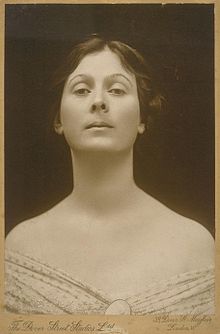Isadora Duncan
| Isadora Duncan | |
|---|---|
 |
|
| Born |
Angela Isadora Duncan May 26, 1877 or May 27, 1878 San Francisco, California, United States |
| Died | September 14, 1927 (aged 49 or 50) Nice, France |
| Nationality | American, Russian |
| Known for | Dance and choreography |
| Movement | Modern/contemporary dance |
Angela Isadora Duncan (May 26, 1877 or May 27, 1878 – September 14, 1927) was an American dancer who performed to acclaim throughout Europe. Born in California, she lived in Western Europe and the Soviet Union from the age of 22 until her death at age 49 or 50, when her scarf became entangled in the wheels and axle of the car in which she was riding.
In 1987, she was inducted into the National Museum of Dance's Mr. & Mrs. Cornelius Vanderbilt Whitney Hall of Fame.
Duncan was born in San Francisco, the youngest of the four children of Joseph Charles Duncan (1819–1898), a banker, mining engineer and connoisseur of the arts, and Mary Isadora Gray (1849–1922). Her brothers were Augustin Duncan and Raymond Duncan; her sister, Elizabeth Duncan, was also a dancer. Soon after Isadora's birth, her father was exposed in illegal bank dealings, and the family became extremely poor.
Her parents divorced when she was an infant, and her mother moved with her family to Oakland. She worked there as a seamstress and piano teacher. From ages six to ten Duncan attended school but, finding it constricting she dropped out. As her family was very poor, she and her three siblings earned money by teaching dance to local children.
In 1896 Duncan became part of Augustin Daly's theater company in New York, but she soon became disillusioned with the form. Her father, along with his third wife and their daughter, died in 1898 when the British passenger steamer SS Mohegan hit some rocks off the coast of Cornwall.
Duncan began her dancing career at a very early age by giving lessons in her home to other neighborhood children, and this continued through her teenage years. Her novel approach to dance was evident in these early classes, in which she "followed [her] fantasy and improvised, teaching any pretty thing that came into [her] head". A desire to travel brought her to Chicago where she auditioned for many theater companies, finally finding a place in Augustin Daly's company. This took her to New York City where her unique vision of dance clashed with the popular pantomimes of theater companies.
Feeling unhappy and unappreciated in America, Duncan moved to London in 1898. There she performed in the drawing rooms of the wealthy, drawing inspiration from the Greek vases and bas-reliefs in the British Museum. The earnings from these engagements enabled her to rent a studio where she developed her work and created larger performances for the stage. From London, she traveled to Paris, where she drew inspiration from the Louvre and the Exposition Universelle of 1900.
...
Wikipedia
